|
|

|

![]()
![]()
Tricycles are of three basic types, and within each there are variations:
Some delta tricycles have front-wheel drive, like the one in the delightful picture of my brother Jim (in 1955), below. These tricycles are close relatives of high-wheeler bicycles.
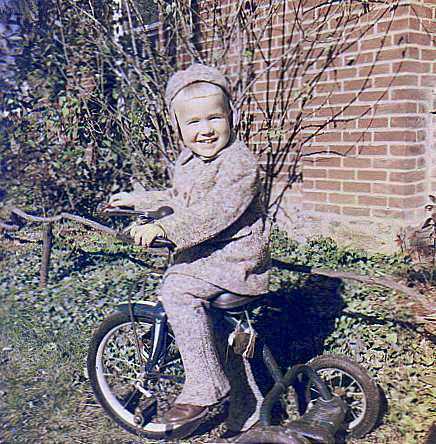
About children's tricycles, see our article about teaching children to ride. Most children's front-wheel-drive delta tricycles these days are recumbents. They are more stable than this 1950s classic.
Sophisticated recumbent racing handcycles are also front-wheel-drive delta tricycles. The video clip below is from the 2011 Boston Marathon.
The traditional delta tricycle has rear-wheel drive and an upright riding position like that of a conventional bicycle. Often only one rear wheel is driven, in which case traction is reduced and one rear tire wears much faster than the other. Some upright tricycles have differential gearing. Separate freewheeling for each of the rear wheels is also common and has the practical advantage that power is not lost if one wheel loses traction. If a delta tricycle carries a heavy load at the rear, then rear-wheel traction is less of a concern, though hard cornering still can be. A delta tricycle has convenient space for baggage or a passenger/passengers between the rear wheels. Rickshaws and pedicabs are delta tricycles, for this reason. The video below is of a pedicab in Provincetown, Massachusetts, USA.
The U.K. has a tradition of upright delta tricycle racing. A racing tricycle does not lean into a turn, and so, once the wheel toward the inside of the turn leaves the ground, a vault to the high side is likely. A skillful upright tricycle racer leans to the inside of a turn to avoid high-siding. Racing delta tricycles have dual handbrakes on the front wheel, as seen in the photo. Some tricycles do lean as they steer, but this increases weight and complexity.
Carl Saint cornering on the way to a win
in the 2009 Tricycle Association (U.Kl) 25 Mile Time Trial Championship
(Photo credit: Martin Purser)
.jpg)
These are sporting machines, and other than they have two rear wheels, have the features of a road-racing bicycle: light weight, derailer gears, hand-lever-operated brakes and a sporting rider position.
Utilitarian upright delta tricycles, on the other hand, are generally heavy and have only a limited selection of gears. -- a three-speed hub, or only a single speed. These tricycles are OK for riding in flatlands, and are commonly seen as rentals in beach resorts. Many people buy these tricycles because they never leaned to balance a bicycle, and not having cycled before, also are not physically fit. This makes the weight and limited gearing even more frustrating, if there are hills to climb. Utilitarian tricycles usually have a coaster (backpedaling) brake, which like the drive, works on only one rear wheel and so, provides weak braking. Some of these tricycles, like the one in the photo below, also have a handbrake on the front wheel.
The photo shows a special, appropriate use of one of these tricycles, and a solution. Unstoppable Boston, Massachusetts-area cyclist Bob Sawyer is seen riding away from his 95th birthday party. He has several decades of experience in riding sporting bicycles, but he can no longer rely on being able to balance a bicycle. His Schwinn tricycle has single-side rear-wheel drive and a single speed -- but he has added a hub motor in the front wheel as with the Provincetown pedicab, for some help when climbing.
![]()
![]()
The drivetrain for a tadpole tricycle is like that of a rear-wheel-drive two-wheeler, except that on a recumbent, the chain must pass under the rider, generally with an idler wheel or two.
The photo below is of a classic Copenhagen cargo tricycle, seen in 2008 at the Clever Cycles store in Portland, Oregon, USA. The design is primitive and this tricycle would be safe only in level terrain (like Copenhagen's) and at low speeds. Steering is by turning the entire cargo box. The two front wheels are on a single axle. A front wheel striking a bump yanks the steering to one side.
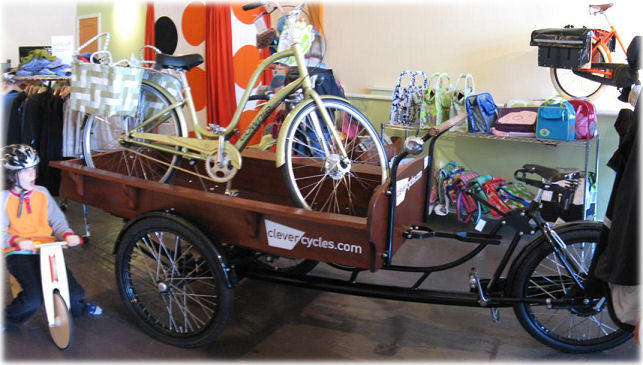
The Copenhagen tricycle has a single speed and a single drum brake on the rear wheel, operated by a lever which pulls up between the rider's knees. The hinged fork which extends back from the cargo box prevents it from turning when the tricycle is parked on an uneven surface.
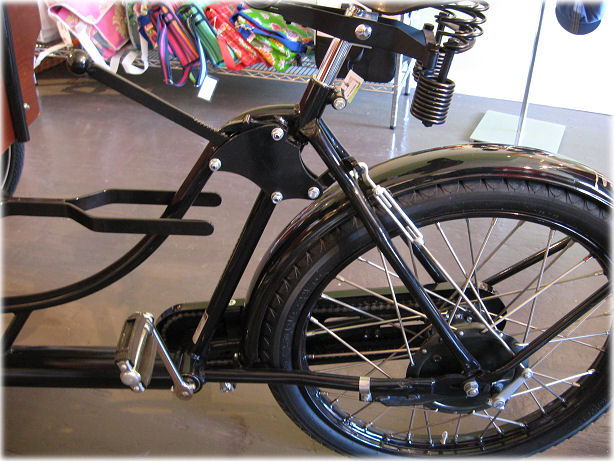
Recumbent tadpole tricycles are generally more sophisticated and have steering geometry which prevents interference from uneven terrain. Sheldon Brown, founder of this site, rode a Greenspeed recumbent when health issues made it difficult for him to mount a bicycle. Unusually, he found that he enjoyed riding it off-road. His article about his tricycling experience is here. Sheldon describes lots of other useful tips and tricks.
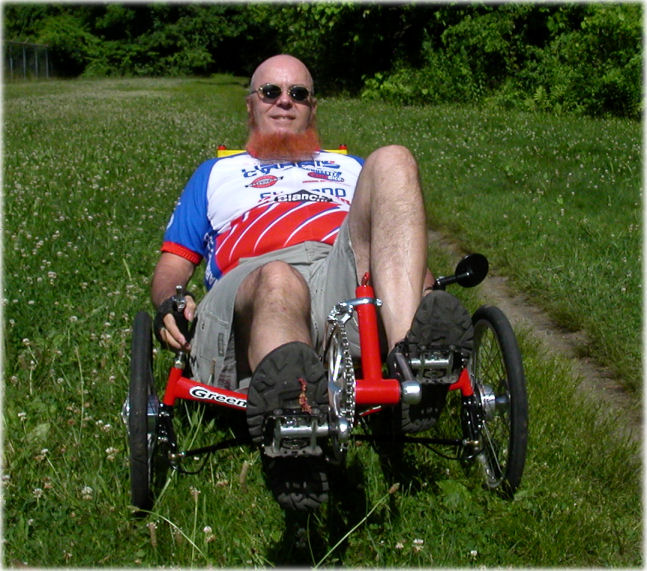
Unlike a recumbent bicycle, a recumbent tadpole tricycle has no potential interference between the cranks and the front wheel. Recumbent tadpole tricycles generally have a brake lever for each hand, operating the brake on the (front) wheel for that side -- bulldozer-like braking. This takes getting used to but it allows braking in proportion to traction, which is greater on the more heavily-loaded outside wheel in a turn. On a slippery surface, steering is possible using the brakes. There is generally no brake for the rear wheel, which is lightly loaded in hard braking and couldn't contribute much additional braking anyway. With a low tadpole tricycle, hard braking when cornering results in a skid rather than a high-side vault. The front wheels must be stronger against side loads than those of a bicycle and are often tilted outward at the bottom, as the heavy side loading pushes from the outside.
A potential hazard with a low tadpole tricycle is "leg suck": if a foot comes off a pedal, it can be dragged underneath the front axle and vault the rider forward. For this reason, foot retention is needed. This can be one of the commercial shoe-pedal systems, or heel rests. Toe clips and straps are inadequate, as a foot can still slip out.
Also see our article on shoe-pedal systems.
A recumbent tadpole tricycle has less room for baggage than a delta tricycle, though a conventional rear rack and panniers may be used.
Any low recumbent tricycle, like a recumbent bicycle, benefits by having a safety flag or other visibility aid.
![]()
![]()
Neither a delta nor a tadpole tricycle is suitable for use on dual-rutted dirt roads. Dual-track tricycles, common in the 1880–1900 period, were designed for such use.
Dual-track tricycle which belonged to William Shakespeare of Waltham, Massachusetts, USA
in the 1880s. (not that other William Shakespeare). Courtesy Waltham Museum.
The cyclist sits between the two tracks. An odd design feature is that the smaller wheels steer in opposite directions-- as they must, because one is ahead of the large driving wheel, the other behind. The front and rear wheel's tire tracks are the same when cornering. It appears that the only brake of this machine, if any, is on the large wheel. This tricycle has chain drive but doesn't use it to gear up so the drive wheel can be smaller -- an interesting example of technology in transition from high-wheeler bicycles.
A bicycle with a sidecar is also in effect a dual-track tricycle. Sidecars have been most common to carry children. Here is one in a photo from Berlin, Germany in 1931. Like many, this one is articulated (hinged) so the bicycle can balance. The higher location of the front hinge compensates, more or less, for the sidecar's wheel's being ahead of the bicycle's rear wheel. As the bicycle leans to the left, the sidecar wheel steers farther left than the bicycle's rear wheel.
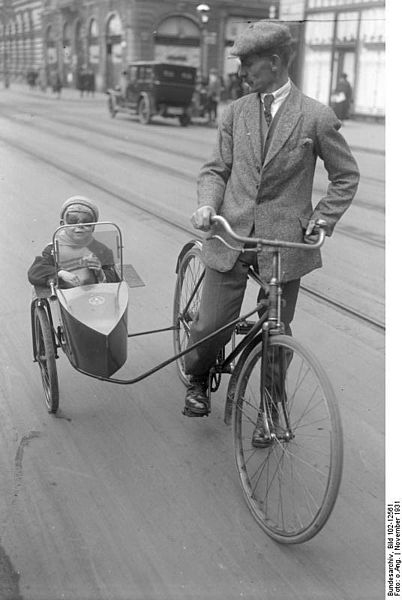
Photo credit: Bundesarchiv, Bild 102-12561 / CC-BY-SA 3.0 [CC BY-SA 3.0 de], via Wikimedia Commons
BMX racing with a sidecar was quite popular in the 1970s and 1980s and has had somewhat of a revival more recently. The passenger stands, with a hand rest, and often helps push along with the feet. The BMX bicycle with sidecar, then, operates more or less like a combined bicycle and push scooter.
The Surly Xtracycle long-tail bicycle can be equipped with a sidecar for cargo. It can be either rigid or hinged. Keri Caffrey, co-founder of CyclingSavvy, reports that the asymmetry seriously affects handling.
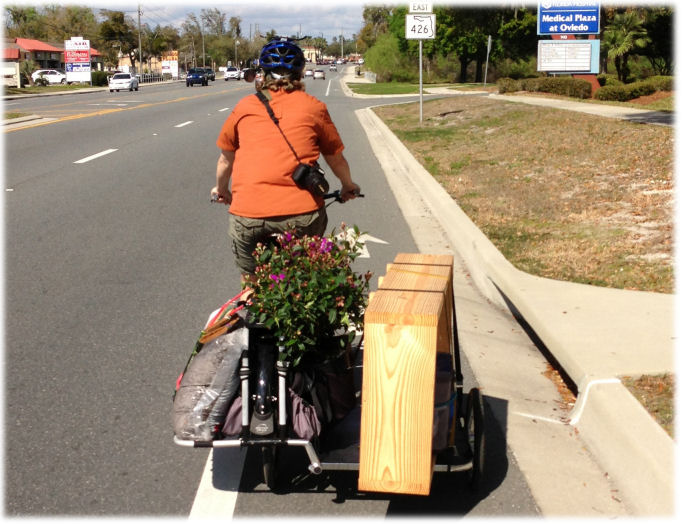
Photo credit: Lisa Walker
Keri comments:
It's awkward to handle. I tried it in trike mode [rigid] and it was weird because you sit over the left wheel. [But with the platform articulating], if I put something heavy on the sidecar, it would pull me down on that side and I had to fight too hard to keep the bike balanced. So I'd load something heavy on the opposite pannier or sideloader to balance it. I almost exclusively carry garden supplies, so I'd just put a couple bags of dirt on the opposite side. I haven't used it in a long time. A trailer is more useful and easier to handle for things that don't fit on the side-loader platforms that attach to the Xtracycle frame.
![]()
![]()
A tricycle is wider than a bicycle and so, lane control is more often necessary (see lane control - i am traffic). Wider human-powered vehicles don't fit into bike lanes, as the photo above illustrates. This problem is worse on paths, where there is not another lane into which to merge.
Any tricycle has the advantage that there is no need to place a foot on the ground to stop and restart. Gears can be extremely low for slow climbing without concern about balance.
The rider must be aware of the separate wheel tracks to avoid surface hazards. With two, or usually three, wheel tracks, avoiding them is more difficult than on a bicycle.
A tricycle can be loaded and unloaded of cargo or passengers without concern that it might fall over. But a tricycle should have some kind of parking brake, so it won't roll away.
A tricycle is larger and more inconvenient to store and carry than a bicycle which would fit the same rider. Carrying a tricycle past obstacles or up and down stairs can be difficult or impossible.
Walking with a tricycle, especially a recumbent tricycle, is clumsier than with a two-wheeler.
All in all, tricycles have advantages over bicycles for certain specialized uses, particularly cargo hauling, and for people who cannot balance a bicycle.
![]()
![]()
Last Updated: by John Allen